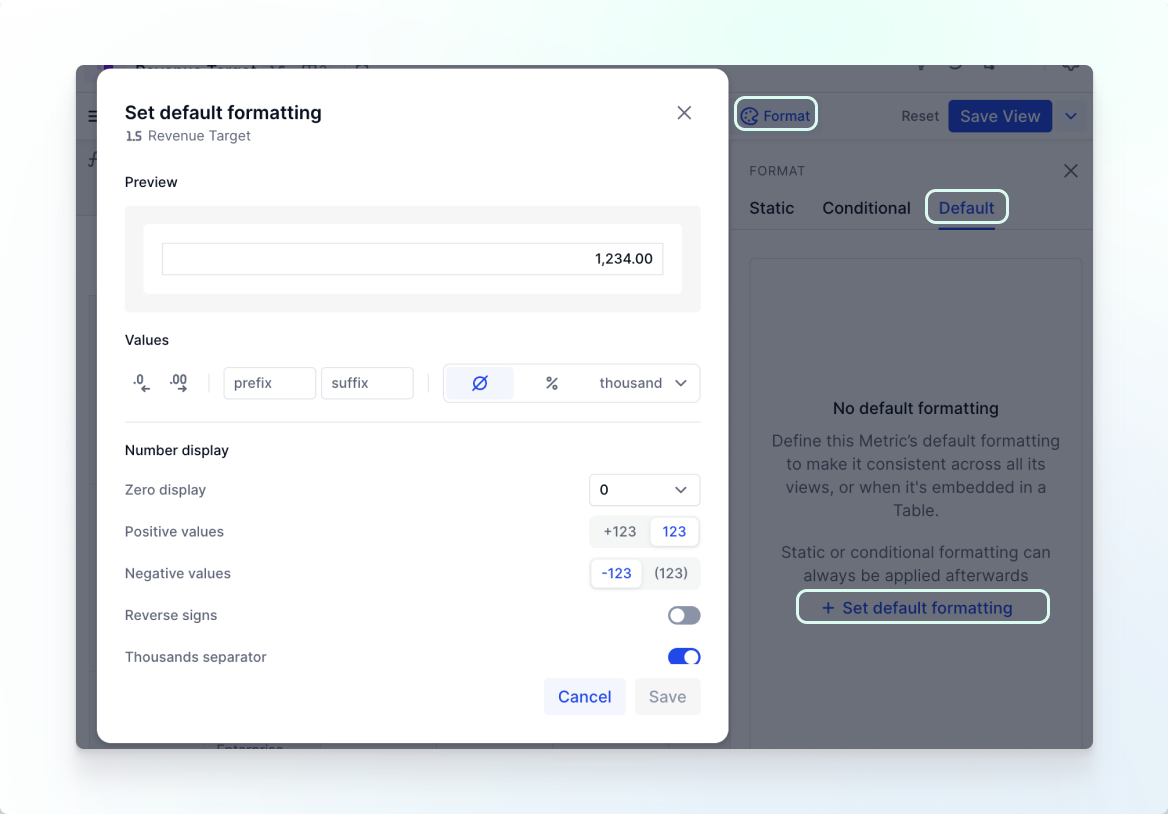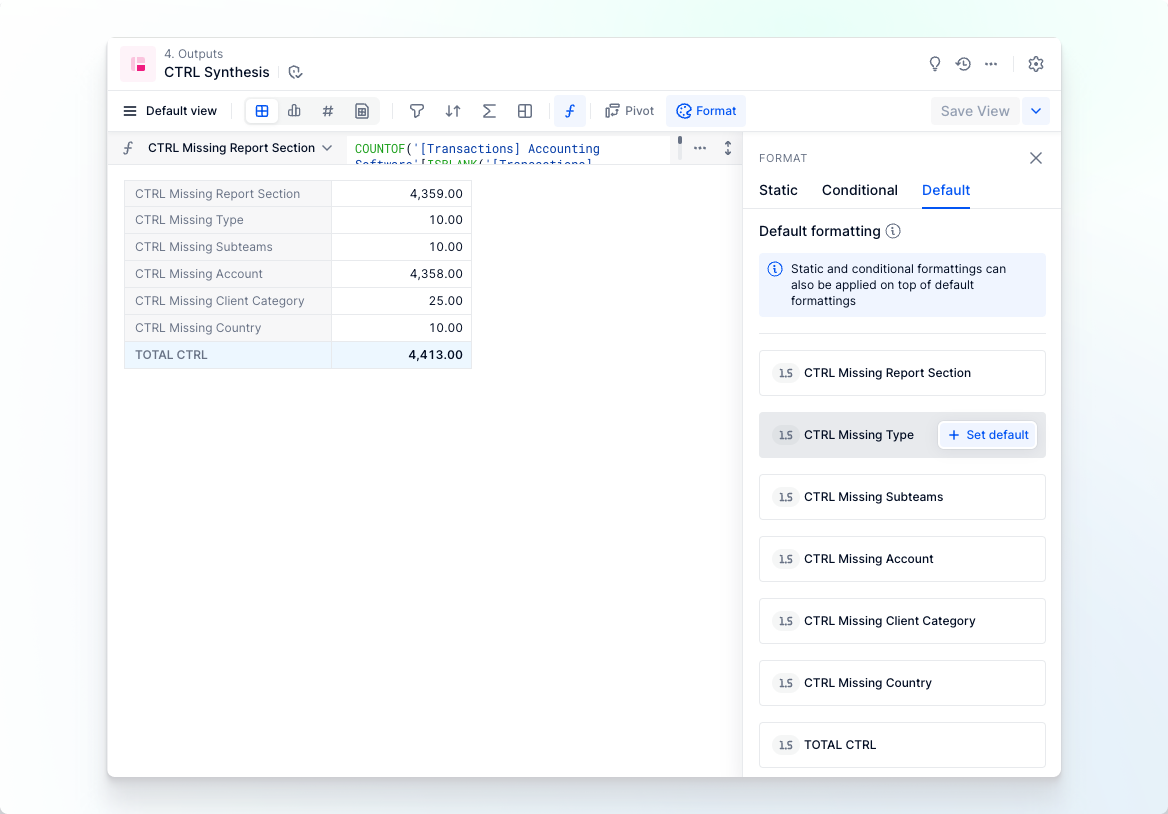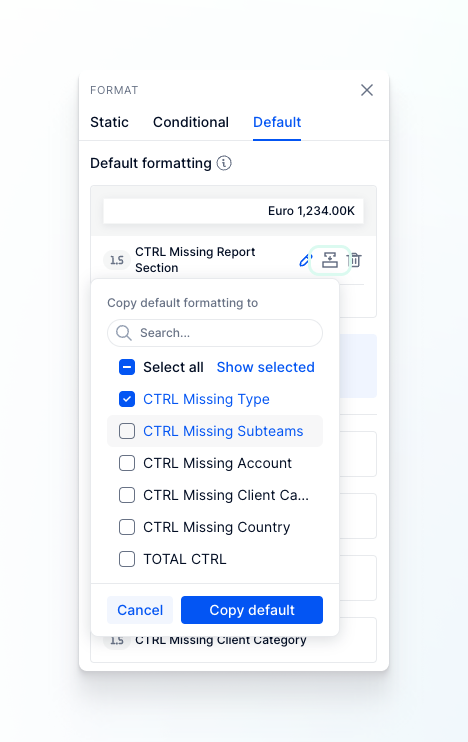Use default formatting in Pigment when you want to apply a specific formatting or style to text or numerical values across all Views and usages where a specific Metric is used.
It allows you to format a Metric only once without needing to reformat it repeatedly. Let’s say you have a Metric that you use in several Views, Tables, and reports. You want to display the Metric as a percentage, and with one decimal only. By applying default formatting to this Metric, you can format it a single time instead of manually formatting it in each location it’s used.
For more information on formatting in Pigment, check out these articles:
- Format and Style Your Data in Pigment
- Apply Static Formatting to Define Different Views
- Apply Conditional Formatting to Highlight Data Changes
Before you Begin
Consider the following before you apply default formatting to Metrics in Pigment:
- You need to have the Configure Block permission.
- You can only apply default formatting to numerical or text Metrics and properties.
- When you apply default formatting to a Metric, the formatting is applied to all cells, Views, and applications where the Metric is used.
- Default formatting doesn’t include formatting to text or background colors, italic or bold formatting to text, or adding cell borders.
- If you have specific formatting requirements but they're not available in default formatting, it's not a problem! First, you apply your default formatting to your Metric. Next, add any other formatting requirements using the static and conditional formatting options. Static and conditional formatting always take precedence over default formatting.
- When default formatting is applied or removed, the Metric is updated across all usages. However, any static and conditional formatting remains applied. Ensure you know where and how a Metric is being used before you make changes to it everywhere!
- When you remove static or conditional formatting from a Metric that has default formatting applied, the default formatting remains.
- When you remove default formatting from a Metric, the default Pigment formatting remains:
- Text Metric. Text is displayed in regular text format.
- Numerical Metric. Numbers have 2 decimal places, and no multiplier, prefix, or suffix is applied.
Apply Default Formatting to Metrics
- Open your required Metric.
- Click Format.
- Select Default and then click + Set default formatting.
- Select the default formatting values you require. The following types of default formatting are described in more detail below:
- Numerical Metrics
- Text Metrics
- Review the final format displayed in the Display field.
- (Optional) Click the Edit icon to update a default format, or click the Delete icon to remove it.

Format Numerical Metrics
For numerical Metrics, select the following options:
Values
-
Decimal. Removes or adds a decimal to the selected cells.
-
Prefix. Adds text before the value
-
Suffix. Adds text after the value
-
Multiplier. Displays values in :
- %
- basis point
- thousands
- millions
- billions
Number display
- Zero value. Select the value you want to show for zero.
Options are0,-, or(empty). - Positive Numbers. Select the value you want to show for positive values.
- Negative value. Select the value you want to show for negative values.
Options available are,-or() - Reverse signs. Activate this option to multiply all the items of a Metric by
-1. - Thousands separator. Activate this option if you want to display a thousand separator.
Format Text Metrics
For text Metrics, select one of the following options:
- Text. Display text without any formatting.
- Rich Text. Apply bold or italic formatting to text in your Metrics.
- Turn URLs into Images. For more information on formatting cells to use images, see Displaying images in Metrics and List properties.
Apply Default Formatting to Metrics from a Table
- Open your required Table.
- Click Format.
- Select Default.
This displays the list of Metrics available in your Table. - Hover over the Metric to which you want to apply default formatting, and click + Set default.

Apply Default Formatting to Metrics from a Table
-
Apply the default formatting that you need.
This is described in the previous section. -
(Optional) Click the Copy icon to apply this default formatting to other Metrics in your table.
You need to apply a default formatting to at least one Metric in your table before you can copy this formatting.

Copy Default Formatting to Other Metrics in the Table -
(Optional) Click the Edit icon to update a default format, or click the Delete icon to remove it.



